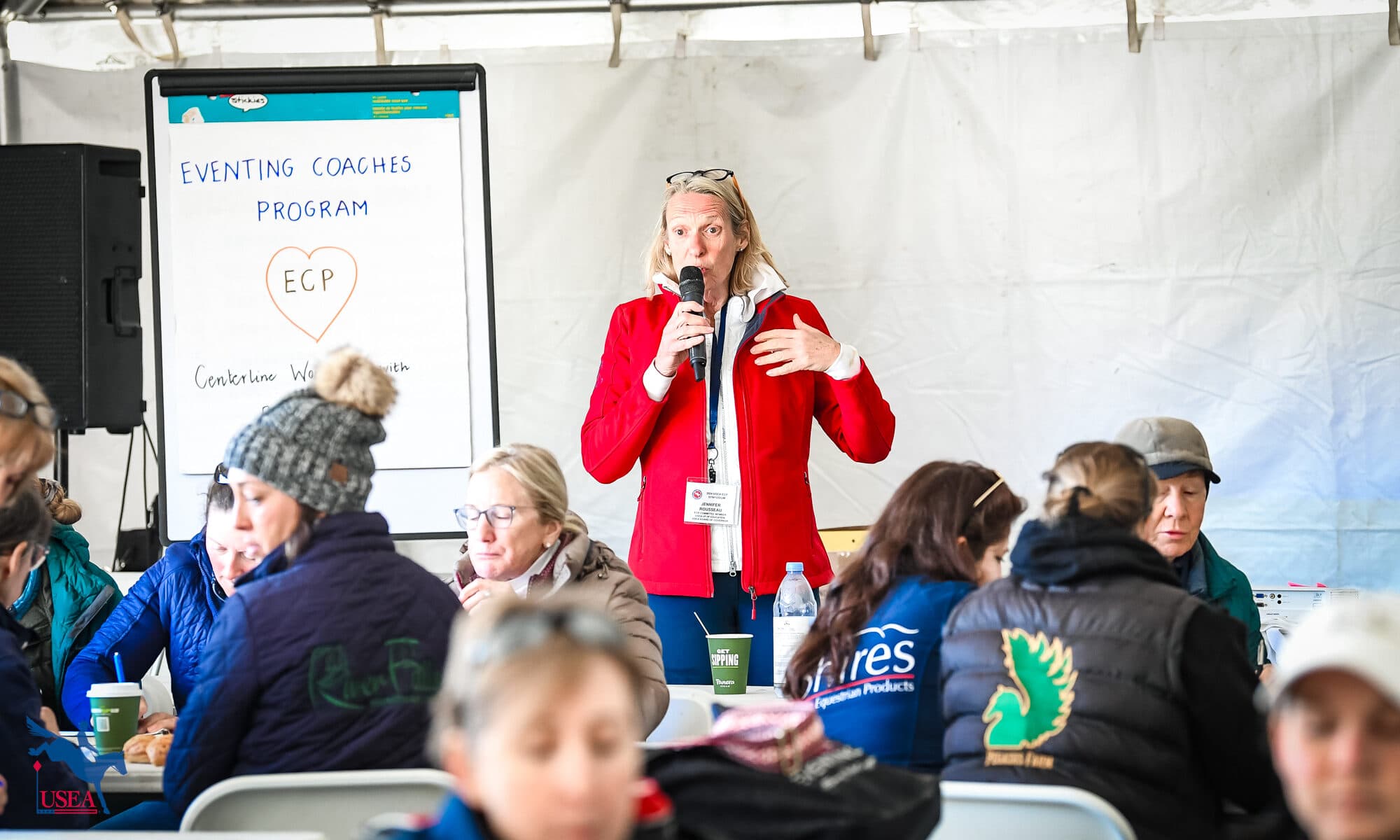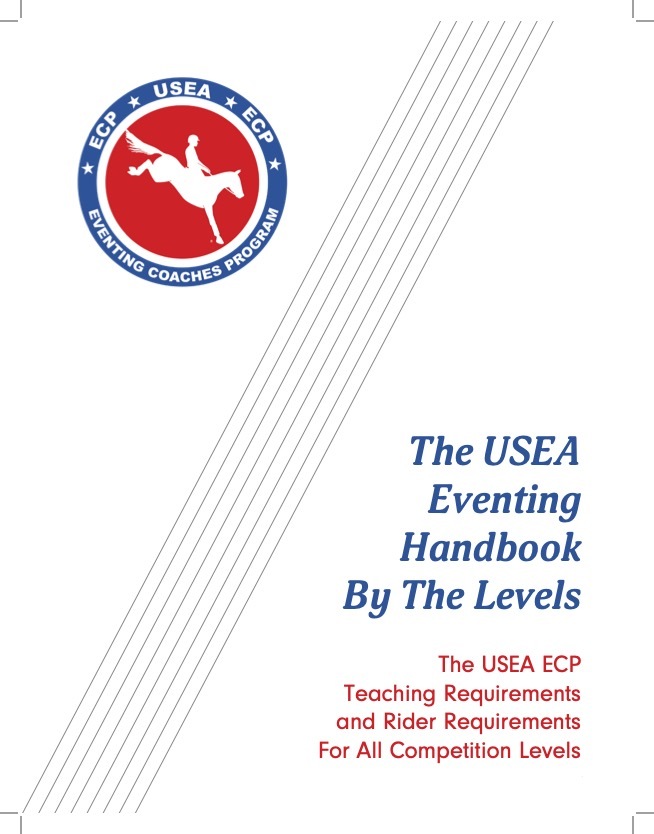The USEA Eventing Handbook by the Levels: Your Ultimate Resource

Many years ago, I composed a document for my students called “The Building Blocks for Learning to Ride.” It covered the progressive stages of learning to ride, from sitting on a horse and holding the reins for the first time to jumping cavalletti and preparing for course work. Each step was numbered. I wrote it so that any student of mine who found themselves stuck, in a rut, or regressing could find where they were on this “Building Block” roadmap and then work backward through the previous blocks to see where they might have missed a step or needed to reconfirm a skill.
This idea stemmed from something my dad asked me when I informed him (around age 15) that I thought I would like to teach riding. My dad was a non-horse guy but was very clever, and he looked me straight in the eye and asked: “What’s your system?”
I thought about that long and hard for a while. I didn’t even know what he meant! What’s a system? Why do I need one? Who cares? A few months later, Dad came home with three books for me. Although my dad embodied the textbook definition of a non-horse guy, he went hunting for books that, in his mind, had clear, understandable, progressive systems for what they were trying to convey about riding and training horses. He read many books, cover to cover, and presented me with these three:
Learn to Ride, Hunt and Show by Gordon Wright
The de Nemethy Method by Burtalan de Nemethy
Schooling Your Horse by Captain Vladimir S. Littauer
Keep in mind: This was the mid-seventies. Many books have been written since. Whether you agree with or implement any of the steps described in those three books is irrelevant (though I highly recommend reading all three). The point my dad was trying to make was the following:
When the concepts and techniques required to learn skills are:
- broken down into manageable, logical steps of achievement, and
- those steps have clear incremental stages of progression, and
- each step has a precisely described required technique or technical application, such that
- the reader can understand and produce repeatable, attainable results,
- the reader is able to learn a lot about how to ride and train.
That is a concept that has stuck with me and has shaped my teaching and training throughout my career.
What’s in a System?
When we look at the powerhouses of equestrian sport at the highest levels, we generally find a common theme—they have all adopted a “system” by which they train and progress their horses. The implementation of these systematic training programs may vary somewhat between individuals, while the basic concepts and principles remain constant. Perhaps the most recognized system (and arguably, one of the most successful) is that of the German Riding Federation, which published two extensive reference books detailing the systematic training of horses and riders and uses that documentation to certify instructors and riders as required to teach and compete in Germany.
Another country with a strong, published system is the United Kingdom, which uses the British Horse Society program as the basis for instructors and riders to progress through the levels. While somewhat less formalized, one could argue that the United States has been recognized for its system of developing horses and riders for the disciplines of hunters and jumpers, primarily promoted for many years by George Morris, but based on the work of many including de Nemethy, Wright, Bill Steinkraus, Littauer, Jean Froissard among many others.
The aforementioned training systems have clear, incremental steps that begin by creating a base skill set (think: the Training Scale—rhythm and relaxation). This skill set includes the development of correct technique in the rider and applies that technique to a repertoire of skills (for example, the application of the aids for various movements is a skill set). This technique and skill set is applicable and adaptable to every horse, not just the one the rider is sitting on at the moment. The repertoire of skills increases in number of skills and level of difficulty (tools in the toolbox) as the rider becomes more proficient. So too does the horse develop his understanding of what is required, learn the correct muscle memory and footwork, and that initial training is followed by developing relaxation, strength, and confidence.

The USEA Eventing Handbook by Levels
Fast forward 45 years from my original quest to develop a “system” to one of my first meetings as a member of the USEA Eventing Coaches Program (ECP) committee where a similar question was brought to the table in one of our brainstorming sessions: “What is our system?”
Not that there is a shortage of excellent reference books on riding and training horses and riders for eventing. However, our sport has evolved exponentially, even in just the past few decades, and continues to progress. The dissolution of the classic format at the international level in the early 2000s created a snowball effect that influenced everything from the type of horse required to excel in the sport, to the required skill set for both horse and rider necessary for navigating the increased technicality of the cross-country course. Add to that the inclusion of multiple lower levels providing entry points to the sport for less experienced riders and increasing the popularity of the sport with amateur enthusiasts; the evolutionary list of changes is long!
Given the significant changes in our sport and the distinct structure of the competition levels in North America, it made sense to develop our own manual. Surrounded and supported by some of the best coaching minds in the country in the ECP Faculty and Committee and supported in the process of development by innovative educators, we set to work to create a reference that would, in a comprehensive and detailed way, provide a roadmap for succeeding in our sport. The resulting document, the USEA Eventing Handbook by the Levels is the definitive reference guide for riders, coaches, instructors, trainers, and parents. It walks you through exactly the riding skills needed to succeed at one level and move to the next. It was designed so someone could not only follow the progressive steps to move forward but perhaps more importantly, be able to trace the steps backward to find the error in training that inhibited progression (because there is ALWAYS a reason for a problem that can be traced to a missed step or a missed confirmation of a skill or technique).
How to Use the “Handbook”
Step 1: There is a detailed description of how to use the Handbook on page 6, which is a good description of how the book was formatted and will help you navigate the roadmap that is the Handbook.
Step 2: Importantly, every student, coach, instructor, official, and parent should begin by reviewing the information in the “Universal Overview.” In these pages, you will find the mainstream principles and concepts which form the foundation for all the information contained therein, at every level, and will give readers a refresher course in the language of our sport.
Step 3: Once you have digested the foundational information, regardless of your level, I recommend you start your trip through the levels by reading the Starter level. This is the “jumping in” point for green riders and green horses. This level is an important read for a couple of reasons:
- Knowing where you came from and how you got there is key to understanding how to move forward,
- It has the most detailed information on the correct position and application of the aids—and is referred to many times in the body of the Handbook,
- It is a simple and straightforward way to introduce yourself to the format of the Handbook. Each competition level has an overview and then is divided by discipline: dressage, show jumping, and cross-country.
Step 4: As you progress through each level, you are provided with the purpose of the level, the expectations of the rider, and the coaching requirements of each level. Each of the three disciplines, at each level, is subdivided into three distinct sections. The Position, Balance, and Aids section details the technique required to produce the required Rider Skills, and the technique and skills combined to execute the Exercises and Concepts, which, once correctly mastered, provide confirmation that the rider is indeed competent at the level.
Examining Progression Comparatively—Your Secret Weapon to Unlocking Problems
As mentioned, the layout and format of the Handbook allows the reader to track progression forward and backward; in other words, find the missing link. For instance, following the dressage “Rider Skills,” first paragraph, at each level from Starter through Modified, the progression begins at basic control, understanding of rhythm, and execution of simple figures at the Starter Level. From there it moves to a more comprehensive understanding of the Training Scale, of contact, and of riding figures in the correct rhythm and balance at the Novice Level.
At the Modified level, the Rider Skills for dressage include producing rhythm, relaxation, suppleness, and connection in their horse throughout transitions and more difficult movements. At any time in the training process, the rider can refer to an earlier level to ask themselves: “Did I really understand? What did I miss? What needs work?” This is true throughout the Handbook and at every level.
The Handbook is for everyone. It can help coaches explain to their students what is needed to move forward, and what is missing. It can help riders understand what is required for each level or where they need to put their training focus, and it can help parents to be able to monitor progression and better understand the coaching their child is receiving.
The Handbook information strengthens and supports top-quality training and instruction at every level, and its intention is to produce an ever-expanding pool of competent, safe riders and horses. It is a remarkable gift to the eventing community and represents the best of the sport of eventing in this country.
All USEA members can access the USEA Eventing Handbook by the Levels, which is available for download on the USEA Member Services dashboard. Non-members can purchase the USEA Eventing Handbook by the Levels at www.shopusea.com.
About the USEA Eventing Coaches Program (ECP)
Coaches are essential to the training of riders and horses for safe and educated participation in the sport of eventing. The USEA Eventing Coaches Program (ECP), formerly known as the Instructors’ Certification Program (ICP), was initiated in 2002 to educate all levels of eventing coaches with crucial training principles upon which they can continue to build throughout their teaching careers. ECP offers educational workshops and assessments by which both regular coaches, Level I through Level V, Young Event Horse (YEH) coaches, and Young Event Horse professional horse trainers can become ECP certified. Additional information about ECP’s goals, benefits, workshops, and assessments as well as names and contact information for current ECP certified coaches, YEH coaches, and YEH professional horse trainers are available on the USEA website. Click here to learn more about the USEA Eventing Coaches Program.
The USEA would like to thank Parker Equine Insurance, the United States Pony Clubs, and Strider for their support of the Eventing Coaches Program.














